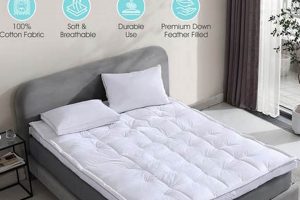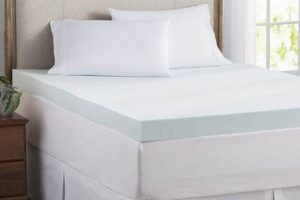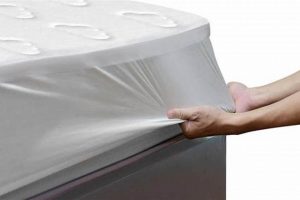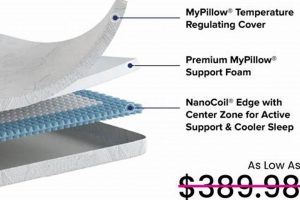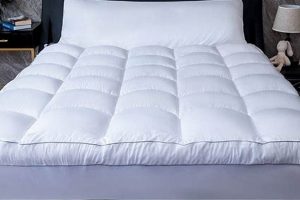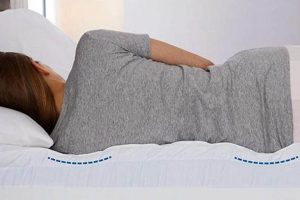A bedding layer, tailored to specific dimensions and material preferences, enhances the comfort and support of an existing sleep surface. For example, individuals with unique physical needs or preferences may opt for a design incorporating specialized foam densities or zoned support regions to alleviate pressure points and promote proper spinal alignment.
The adaptability inherent in this approach offers several advantages. It allows for the modification of a mattress’s feel, extending its lifespan and potentially delaying the need for a full replacement. Furthermore, the ability to select specific materials addresses concerns such as allergies or temperature regulation, leading to a more restful sleep environment. Historically, similar concepts have existed in rudimentary forms, utilizing materials like feathers or straw to adjust sleep surface characteristics.
The following sections will delve into the various materials used in these bespoke bedding components, the factors to consider when specifying dimensions and features, and the process involved in commissioning a tailored sleep solution.
Considerations for a Tailored Sleep Surface Enhancement
Selecting a modified bedding layer requires careful deliberation to ensure optimal comfort and support. Prioritize the following aspects for a well-informed decision.
Tip 1: Material Selection: Evaluate material properties according to individual needs. Memory foam offers pressure relief, while latex provides responsiveness and durability. Wool promotes temperature regulation, and down offers a plush feel. Analyze material certifications to confirm the absence of harmful chemicals.
Tip 2: Density and Firmness: The density of the core material impacts its support characteristics and longevity. Higher density materials generally offer increased durability. Firmness should align with preferred sleep position and body weight. Side sleepers typically benefit from softer surfaces, while back and stomach sleepers may require firmer support.
Tip 3: Thickness and Profile: The profile height influences the overall bed height and should be compatible with existing bedding. A thicker layer can significantly alter the feel of the underlying mattress. Consider the impact on fitted sheet compatibility.
Tip 4: Zoned Support: Certain designs incorporate differentiated support zones to target specific areas of the body, such as the shoulders and hips. This feature can enhance spinal alignment and alleviate pressure points.
Tip 5: Customization Options: Explore available options for personalization, including adjustable firmness levels, integrated cooling technologies, and hypoallergenic treatments.
Tip 6: Measurement Accuracy: Precise measurements of the existing mattress are critical for a proper fit. Account for any existing irregularities or protrusions. Poorly measured dimensions can compromise performance and comfort.
Tip 7: Vendor Reputation and Warranty: Research vendor reputation, reviews, and warranty terms. A reputable vendor will provide clear product information and offer recourse in case of defects.
Careful consideration of these elements will contribute to the selection of a personalized sleep solution that addresses individual comfort and support requirements.
The subsequent sections will address frequently asked questions and explore alternative solutions for enhancing sleep surface comfort.
1. Precise Size
The correlation between dimensions and the effectiveness of a modified sleep surface is direct and significant. Accurate measurements are paramount to ensure the enhancement performs as intended, providing consistent comfort and support across the entire sleep area. For instance, a topper that is too small will leave portions of the original mattress exposed, creating unevenness and negating the intended benefits. Conversely, an oversized unit will overhang the edges, potentially causing slippage, accelerated wear, and discomfort due to restricted movement.
The integration of precise sizing extends beyond mere surface area. Depth considerations also play a role, especially when utilizing fitted sheets. A sleep surface that deviates significantly from standard dimensions may necessitate specialized bedding, increasing costs and potentially limiting available options. Customization often entails non-standard thickness. Therefore, precise specification of all three dimensions is required. A lack of attention to detail during the measurement phase directly impacts the user experience and the overall value proposition of the product.
In conclusion, meticulous attention to dimension is not merely a desirable attribute; it is a fundamental requirement for optimal performance. Dimensional inaccuracies compromise support, comfort, and durability, ultimately diminishing the intended advantages. Precise sizing serves as a cornerstone for a successful deployment. This understanding is crucial for ensuring the investment aligns with desired outcomes.
2. Material Density
Material density, in the context of modified sleep surfaces, is a crucial determinant of performance characteristics, influencing support, durability, and overall comfort. The mass per unit volume of the core material directly impacts its ability to resist compression and provide consistent support over time.
- Support and Pressure Relief
Higher density materials generally offer enhanced support and resistance to compression, which is particularly relevant for individuals seeking pressure relief and spinal alignment. For example, a high-density memory foam topper will distribute weight more evenly, reducing pressure points on the shoulders and hips. Conversely, a low-density foam may compress excessively, leading to inadequate support and discomfort.
- Durability and Longevity
Density directly correlates with the lifespan of the product. Higher density materials are more resistant to degradation from repeated compression and use. A high-density latex topper, for instance, is expected to maintain its shape and support characteristics for a longer period compared to a lower density alternative. This translates to a more durable and cost-effective solution over time.
- Temperature Sensitivity
Material density can indirectly influence temperature regulation. Denser materials may retain more heat, potentially leading to a warmer sleep environment. Conversely, open-cell foam structures, often found in lower density materials, can promote airflow and improve breathability. The selection of density should consider individual temperature preferences and environmental factors.
- Weight and Handling
Density impacts the overall weight of the unit. Higher density materials contribute to increased weight, which can affect ease of handling
and installation. This is a practical consideration, particularly for individuals who may need to frequently move or adjust the positioning of the bedding layer.
In summary, material density is a key performance indicator for modified sleep surfaces. Careful consideration of this attribute is essential for selecting a product that aligns with individual needs and preferences, ensuring optimal comfort, support, and longevity. Understanding the relationship between density and these factors enables informed decision-making and maximizes the value proposition of the product.
3. Firmness Level
Firmness level represents a critical parameter in the specification of a modified sleep surface, directly influencing the tactile experience and biomechanical support provided to the user. Appropriate selection is paramount to achieving optimal sleep quality and minimizing musculoskeletal discomfort.
- Spinal Alignment and Posture
Firmness dictates the degree of support offered to the spine, impacting overall posture during sleep. A surface that is too soft may allow excessive sinking, leading to spinal misalignment and potential back pain. Conversely, an overly firm surface may fail to conform to natural body contours, creating pressure points. Optimal firmness promotes neutral spinal alignment, distributing weight evenly and reducing strain on joints and muscles.
- Pressure Distribution
The ability of a modified sleep surface to distribute pressure effectively is directly tied to its firmness. Softer surfaces tend to conform more readily to body contours, reducing localized pressure on bony prominences such as hips and shoulders. Firmer surfaces, while providing more support, may require a thicker comfort layer to prevent pressure buildup. The ideal firmness level balances support with pressure relief, minimizing discomfort and promoting circulation.
- Sleep Position Compatibility
Different sleep positions necessitate varying levels of firmness to maintain spinal alignment and comfort. Side sleepers typically benefit from softer surfaces that allow the shoulder and hip to sink in, reducing pressure on these areas. Back sleepers generally require a medium-firm surface to support the natural curvature of the spine. Stomach sleepers often prefer firmer surfaces to prevent excessive sinking of the abdomen, which can strain the lower back. Considering preferred sleep position is crucial when selecting a firmness level.
- Body Weight Considerations
Body weight influences the perceived firmness of a sleep surface. Individuals with higher body weights may require firmer surfaces to prevent excessive compression and maintain adequate support. Conversely, lighter individuals may find softer surfaces more comfortable, as they provide sufficient pressure relief without compromising support. Appropriate firmness selection should account for individual body weight and distribution.
Ultimately, the selection of an appropriate firmness level is a highly individual decision, dependent on a confluence of factors including sleep position, body weight, and personal preferences. The modified sleep surface should provide adequate support to maintain spinal alignment, distribute pressure effectively, and promote a comfortable and restful sleep experience. A careful assessment of these factors is essential for optimizing the benefits.
4. Zoned Support
Within the realm of modified sleep surfaces, zoned support represents a targeted approach to optimize comfort and postural alignment. This technology tailors the firmness and resilience of specific areas to accommodate varying body weights and pressure points, thereby enhancing the overall sleep experience.
- Targeted Spinal Alignment
Zoned support addresses the differential pressure exerted by various body regions on the sleep surface. A common implementation features firmer support in the lumbar region to prevent excessive sinking of the hips, promoting spinal alignment. Conversely, softer zones may be incorporated in the shoulder region to accommodate side sleeping and reduce pressure on the joint. This individualized approach is crucial for individuals with pre-existing back pain or those seeking preventative ergonomic support. For instance, an athlete recovering from a spinal injury may benefit from targeted lumbar support that is typically available in custom implementations.
- Pressure Point Relief
By strategically varying the firmness and composition of distinct zones, pressure points are effectively mitigated. The application of softer materials or convoluted foam structures in areas such as the shoulders and hips allows for greater contouring and pressure redistribution. This feature is particularly beneficial for individuals with arthritis or other conditions that cause joint pain. A person experiencing hip bursitis may find significant relief from a modified surface that incorporates a softer, more compliant zone beneath the hip region, reducing direct pressure.
- Customizable Comfort Profiles
Zoned support enables a degree of customization beyond uniform firmness levels. Individuals can specify the precise configuration of support zones to address their unique needs and preferences. This may involve adjusting the size, shape, and firmness of individual zones to accommodate varying body shapes, sleep positions, or specific areas of discomfort. A pregnant woman, for example, might require specialized support in the abdominal region or enhanced pressure relief in the hip area, functionalities more easily achieved with a modified implement.
- Enhanced Motion Isolation
While primarily focused on support and pressure relief, zoned construction can also contribute to improved motion isolation. By decoupling specific areas of the sleep surface, the transmission of movement is reduced, minimizing disturbance caused by a partner’s movements during the night. This is achieved by creating distinct zones with varying degrees of interconnectedness. Consider a couple where one partner frequently tosses and turns; targeted zones could greatly reduce motion transmittal.
In conclusion, the integration of zoned support within a custom sleep surface represents a sophisticated approach to personalized comfort. By addressing specific postural and pressure-related concerns, this technology offers the potential to enhance sleep quality and alleviate discomfort, catering to individual needs and preferences in a manner that standard offerings cannot readily replicate. These modified sleep surfaces offer nuanced adjustments.
5. Thickness Profile
The thickness profile of a modified sleep surface directly influences its impact on the existing mattress’s characteristics, encompassing both the perceived comfort and the overall biomechanical support provided. The selection of an appropriate thickness necessitates careful consideration of individual needs and preferences.
- Impact on Support and Pressure Relief
A thicker profile typically provides a greater capacity for contouring
and pressure relief, particularly when composed of compliant materials such as memory foam or latex. This can be especially beneficial for individuals seeking to alleviate pressure points on bony prominences. For instance, a side sleeper may benefit from a thicker profile to allow the shoulder and hip to sink in, maintaining spinal alignment. Conversely, an individual seeking firmer support may opt for a thinner, denser profile to minimize sinkage and maintain a more stable sleep surface. - Influence on Bed Height and Aesthetics
The thickness profile directly affects the overall height of the bed, a factor that can impact accessibility and aesthetic considerations. An excessively thick profile may render the bed too high for comfortable entry and exit, while a profile that is too thin may not provide sufficient modification to the existing mattress’s characteristics. Furthermore, the increased height may necessitate the purchase of deeper fitted sheets to accommodate the additional volume. A bed in a room with low ceilings may not accommodate a thick modification without appearing disproportionate.
- Compatibility with Existing Bedding
The thickness profile must be considered in conjunction with existing bedding to ensure proper fit and functionality. Fitted sheets must have sufficient depth to accommodate the added thickness without undue strain or slippage. Furthermore, the use of a thicker profile may necessitate adjustments to mattress protectors or other bedding accessories. Failure to consider these compatibility issues can result in discomfort, reduced lifespan of bedding, and compromised performance of the modified sleep surface. Consider that many standard sheets only accommodate a mattress and topper combination of a certain thickness.
- Thermal Properties and Airflow
The thickness profile can influence the thermal properties of the sleep surface, impacting temperature regulation and overall comfort. Thicker profiles may retain more heat, particularly if composed of dense, non-breathable materials. Conversely, thinner profiles may promote greater airflow and reduce heat retention. The selection of an appropriate thickness should consider individual temperature preferences and environmental factors to ensure a comfortable sleep environment. A thinner profile could allow for better heat transfer, mitigating overheating.
In summation, the thickness profile of a custom mattress surface plays a pivotal role in determining its suitability and effectiveness. Careful consideration of support needs, aesthetic preferences, bedding compatibility, and thermal properties is crucial for selecting a profile that optimizes comfort, support, and overall sleep quality. Therefore, a thorough assessment ensures the final solution aligns precisely with individual requirements and existing infrastructure.
Frequently Asked Questions Regarding Custom Mattress Toppers
The following addresses common inquiries pertaining to the selection, implementation, and maintenance of personalized sleep surface enhancements.
Question 1: What are the primary advantages of a custom-designed sleep surface enhancement compared to standard, mass-produced alternatives?
The principal benefit lies in the ability to tailor the material composition, dimensions, and support characteristics to precisely match individual needs and preferences. Standard products often necessitate compromise, failing to adequately address specific requirements related to pressure relief, postural support, or temperature regulation. A custom implementation offers targeted solutions unavailable in off-the-shelf options.
Question 2: How is the appropriate firmness level determined for a custom unit?
Firmness selection is contingent upon several factors, including preferred sleep position, body weight, and the existing mattress’s characteristics. Side sleepers typically benefit from softer surfaces that allow for shoulder and hip contouring, while back sleepers generally require a medium-firm surface to support the natural spinal curvature. Body weight influences the degree of compression experienced, necessitating adjustments to firmness accordingly. A comprehensive assessment of these factors is essential for optimal results.
Question 3: What materials are typically employed in the construction of these modified sleep surfaces, and what are their respective advantages?
Common materials include memory foam, latex, and various fiber fills. Memory foam offers superior pressure relief and contouring, conforming to the body’s shape. Latex provides a more responsive and resilient feel, promoting airflow and breathability. Fiber fills, such as wool or down, offer insulation and a plush feel. The selection of materials should be based on individual comfort preferences and any relevant allergies or sensitivities.
Question 4: How does the thickness profile influence the performance of a custom unit?
The thickness profile dictates the degree to which the unit modifies the existing mattress’s characteristics. A thicker profile generally provides greater pressure relief and support, but may also increase bed height and necessitate adjustments to bedding. A thinner profile offers a more subtle modification, preserving the existing mattress’s feel while adding a layer of comfort. The optimal thickness depends on the desired level of enhancement and compatibility with existing infrastructure.
Question 5: What is the typical lifespan of a custom-designed sleep surface enhancement, and what factors influence its longevity?
The lifespan is contingent upon the quality of materials used, the density of the core material, and the level of care provided. Higher density materials and proper maintenance practices, such as regular rotation and cleaning, can significantly extend the lifespan. A well-constructed unit using high-quality materials can be expected to last several years, providing sustained comfort and support.
Question 6: What considerations should be taken into account when specifying the dimensions of a custom-made implementation?
Accurate measurements of the existing mattress are paramount to ensure a proper fit. Account for any existing irregularities or protrusions. Undersized units will leave portions of the mattress exposed, while oversized units may overhang the edges, causing slippage and discomfort. Precise measurements of length, width, and depth are essential for optimal performance and longevity.
In summary, a thorough understanding of material properties, firmness levels, and dimensional considerations is crucial for selecting a custom sleep surface enhancement that effectively addresses individual needs and preferences. Careful deliberation and informed decision-making are essential for maximizing the benefits and ensuring a restful sleep experience.
The subsequent section will explore alternative solutions for enhancing sleep surface comfort and addressing specific sleep-related concerns.
In Conclusion
The preceding exploration has elucidated the multifaceted nature of the custom mattress topper. Key points encompass material selection, density considerations, firmness calibration, zoned support implementation, and thickness profile optimization. Each parameter exerts a distinct influence on the final product’s performance, necessitating careful consideration during the specification process. Precise measurements and an understanding of individual sleep requirements are paramount for achieving optimal results.
The utilization of a tailored sleep surface enhancement represents a significant investment in long-term well-being. While mass-produced alternatives may offer a more economical initial outlay, the c
apacity to precisely calibrate comfort and support characteristics ultimately yields a superior and enduring sleep experience. Further research and development in material science and biomechanical engineering promise to further refine the efficacy and personalization capabilities of such custom sleep solutions. Individuals should consult qualified professionals to assess specific needs and make informed decisions regarding their sleep environment.


